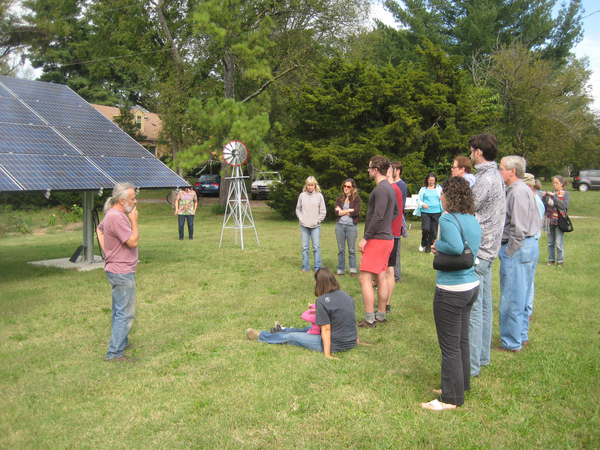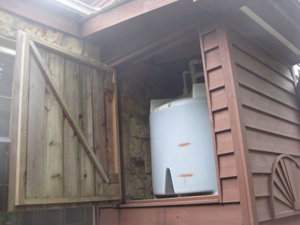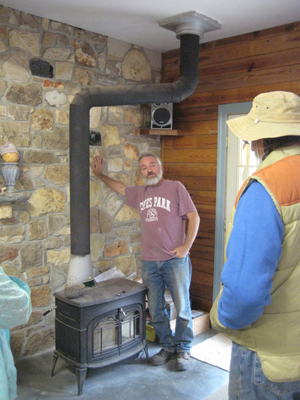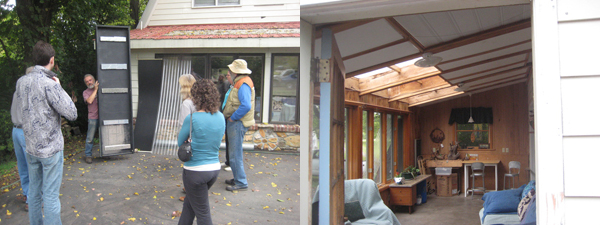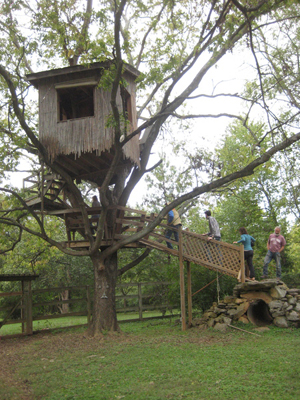The idea of what constitutes a home is ever changing; to the Cherokee it meant a movable tipi, to Native Americans in the Northeast it meant a more permanent and communal wigwam. The early European Americans brought with them homes more similar to what we might recognize today, even if only in form. When you step through the doorway of a modern home, you enter an entirely different beast. The American home of today is a dynamic structure and relies primarily on electricity from coal (42 percent), natural gas (25 percent) and nuclear (19 percent) to feed its voracious appetite. Only 13 percent of electricity in the US currently comes from renewable sources (EIA 2011).
Energy production, however, is only one part of the equation. You may be familiar with the motto, “The greenest product is the one you never produce.” This idea has the somewhat less familiar energy corollary, “The greenest energy is the kilowatt you never produce.” The US as a whole uses 13 times as much electricity as in 1950, 37 percent of which is residential. To help solve the energy problem, one can turn to buzz words like Eco and Green, or you can just look at it as a more common sense approach to home energy. On Oct. 8, Nashville hosted the first annual eco home tour, which showcased residential energy leaders in our area.
The home of Eric and Beth Lewis is nestled just off the Harpeth River, southeast of Nashville. From the road, you see the beautiful shiny black of a 4.2 kW solar array anchored in concrete directly in front of a PVC-framed greenhouse. The couple has been shaping their home for the past 25 years, and there are no signs of slowing down. Turnout was great, and we were divided into two groups. Eric led the energy part of the tour, while Beth concentrated on the agricultural side.
Eco Home: Perspective I – Energy
The Lewis’s 4.2 kW solar array was no small investment, costing around $18,000. Eric shopped around for some time, and chose Sundog Solar for the installation. They decided on polycrystalline solar panels with micro inverters on each panel, instead of the more common string inverter which covers the entire array. Micro inverters allow for performance monitoring of individual panels, as opposed to the entire system. String inverters adjust to the weakest link in an array, so the efficiency of the entire system can be hampered by a single panel. Micro inverters are around 30 percent more expensive, however. The standard performance guarantee for solar panels is 80 percent output after 25 years. The Lewis’s system is available to view online at enlighten.enphaseenergy.com. There is currently a 30 percent federal rebate on the installed price of solar systems, as well as a $1,000 TVA rebate when you turn your system on. TVA also guarantees a premium for electricity that a homeowner feeds back into the grid, which is similar to Germany’s successful PV incentive program (Germany, even with its size and northern location, is a world leader in solar.).
After the solar panel display, we moved on to the Lewis’s solar water heater. A 10’ x 40’ collector sits on top of their roof, which is made of a reflective encasement that houses copper tubing. The unit heats water to about 160 degrees Farenheit. There are two kinds of solar water heating systems: direct and indirect. A direct system heats the water that enters a hot water tank. An indirect system makes use of a heat exchanger and a transfer fluid, which is the same principle that an AC system or refrigerator make use of. A small pump circulates water throughout the system. The latter method, although more expensive (the heat exchanger unit alone costs around $900), offers some distinct advantages. An indirect heat exchanger model achieves a higher efficiency and also allows for greater flexibility in system design. Eric estimates that they cover around 75 percent of their water-heating energy this way, with an approximate seasonal breakdown of 100 percent in the summer, 75 percent in the fall and spring and 50 percent in the winter.
A second, more DIY solar water heater is also in the works. It will make use of coroplast, which is the material you see in political yard signs (Solar heating is a far more sensible use, in my not so humble opinion.). Instead of expensive copper tubing, pex plastic piping will be used, which is now the standard in residential plumbing. EPDM rubber, aka pond liner, will be draped in a plywood box to construct the heat exchanger. Eric estimates that he will need three times the length of pex piping to account for the lower rate of heat transfer (compared to copper). And as a final note on the DIY water heater, it will be much lighter than the purchased version, and will have to be secured to the roof.
The final part of the energy tour covered Eric’s workshop building, which is heated with passive solar. The concept makes use of a south-facing front room with windows along the front and top. The adjoining workshop, which has an apartment above it, has an insulated concrete floor that is 1 foot thick. Even during the winter months, the sun reaches well into the midpoint of the room, heating the thermal capacitor. Easily retractable panels allow the room to be isolated at night. A cast iron stove provides additional heating.
Eco Home: Perspective II – Agriculture
With food in American grocery stores having a whopping 1,500-food-mile footprint on average, no serious discussion of eco anything can ignore the need for a local food economy. Beth has been an active gardener since helping her grandmother with tomatoes as a child. This portion of the home tour started with a walk through beautiful wooded territory, with seven canine companions darting ahead and behind us all of the way. We passed pecan, Chinese chestnut, American chestnut, black walnut, shag-bark hickory, mulberry, pear, plum, apple, paw-paw and cherry trees and eventually arrived at a wooden deck stretching out a few feet over the Harpeth. We continued through a gate to arrive at a large garden which was then covered in black plastic for the winter. A looming wild pear tree stood in a field next to the garden. Beyond the garden stood an old house that was ruined in the great Nashville flood of 2010. After touring the grounds, we made our way back to the greenhouse. Beth gave me two varieties of tomatoes to save seeds from: a yellow globe as well as an Italian Myona heirloom.
Eco Home: Perspective III — the craziest tree house I have ever seen
Also on the premise was a soaring tree house, straight out of the pages of The Swiss Family Robinson. Eric had just replaced the planks a week before our visit. The structure felt solid and would be a great location for a coffee and a planning session for the eco revolution. Eric mentioned one story that, although having no bearing on the eco tour, offers some rich imagery. He and his wife sometimes spend clear nights on the deck of the tree house, with only the stars above them and the animals of the night below them. Tennessee mosquitoes are not a problem 30 feet off the ground. One particular night grew quite stormy, and Eric was left alone in the tree with his mixed boxer Max as the rain and wind beat against the secured window flap. On another occasion, a deer looked up and stared in amazement at the dog above her!
A favorite phrase when discussing any ‘eco’ technology is low-hanging fruit. A solar array is not an example of this, as it comes with some hefty up-front costs. Choosing not to own a clothing dryer, however, is. So is a homemade hot water heater, as well as a solar cooker. There are steps that we can all take to reduce our energy footprint, which in the global context is gargantuan. On the production side, we can choose programs such as TVA’s Green Power Switch to promote change; on the demand side we can look to energy leaders such Eric and Beth. And perhaps most of all, keep in mind that this stuff is fun! Once you finish your first project and see your bill start coming down, the idea of a second and a third project will surely follow. You will have something interesting and novel to discuss at church or with friends rather than the mundane details of some TV show. Before you know it, your neighbors will be strolling by and asking questions, which is also known as community.



